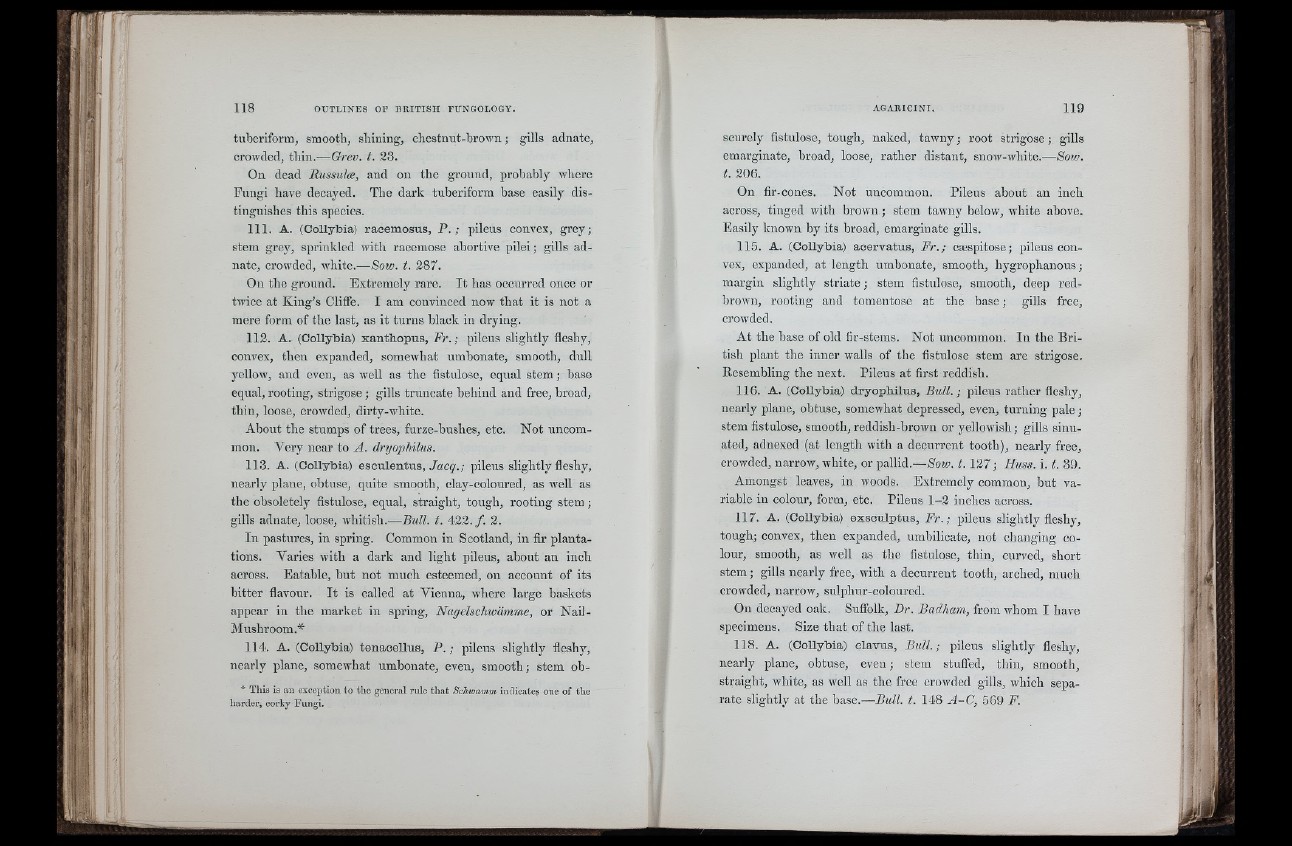
tuberiform, smooth, shining, chestnut-brown ; gills adnate,
crowded, thin.—Grev. t. 23.
On dead Russulæ, and on the ground, probably where
Fungi have decayed. Tho dark tuberiform base easily distinguishes
this species.
111. A. (Collybia) raoemosns, P . ; pileus convex, grey;
stem grey, sprinkled with racemose abortive pilei ; gills adnate,
crowded, white.—Sow. t. 287.
On the ground. Extremely rare. I t has occurred once or
twice at King’s Cliffe. I am convinced now that it is not a
mere form of the last, as it turns black in drying.
113. A. (Collybia) xanthopns, Fr.; pileus slightly fleshy,
convex, then expanded, somewhat umbonate, smooth, dull
yellow, and even, as well as the fistulöse, equal stem ; base
equal, rooting, strigose ; gills truncate behind and free, broad,
thin, loose, crowded, dirty-white.
About the stumps of trees, furze-bushes, etc. Not uncommon.
Very near to A. dryophilus.
113. A. (Collybia) esculentus, Jacg.; pileus slightly fleshy,
nearly plane, obtuse, quite smooth, clay-coloured, as well as
the obsoletely fistulöse, equal, straight, tough, rooting stem ;
gills adnate, loose, whitish.—Bull. t. 4&2.f. 2.
In pastures, in spring. Common in Scotland, in fir plantations.
Varies with a dark and light pileus, about an inch
across. Eatable, hut not much esteemed, on account of its
bitter flavour. I t is called at Vienna, where large baskets
appear in the market in spring. Nagelschwämme, or Nail-
Miishroom.*
114. A. (CoUybia) tenaceUns, P. ; pilens slightly fleshy,
nearly plane, somewhat umbonate, even, smooth ; stem ob-
* This is an exception to the générai rule that Schwamm indicate? one o f the
harder, corky Fungi.
scurely fistulöse, tough, naked, tawny; root strigose; gills
emarginate, broad, loose, rather distant, snow-white.—Soiv.
t. 206.
On fir-cones. Not uncommon. Pileus about an inch
across, tinged with brown ; stem tawny below, white ahove.
Easily known by its broad, emarginate gills.
115. A. (Collybia) acervatus, Fr.; ca;spitose; pileus convex,
expanded, at length umbonate, smooth, hygrophanous;
margin slightly striate; stem fistuloso, smooth, deep red-
brown, rooting and tomentose at the base; gills free,
crowded.
At the base of old iir-stems. Not uncommon. In the British
plant the inner walls of the fistulöse stem are strigose.
Resembling the next. Pileus at first reddish.
116. A. (Collybia) dryophilus, Bull.; pileus rather fleshy,
nearly plane, obtuse, somewhat depressed, even, turning pale;
stem fistulöse, smooth, reddish-hrown or yellowish; gills sinu-
ated, adnexed (at length with a decurrent tooth), nearly free,
crowded, narrow, white, or pallid,—Sow. t. 127; Huss. i. t. 39.
Amongst leaves, in woods. Extremely common, but variable
in colour, form, etc. Pileus 1 -3 inches across.
117. A. (Collybia) exsoulptus, Fr.; pileus slightly fleshy,
tough; convex, then expanded, umbilicate, not changing colour,
smooth, as well as the fistulöse, thin, curved, short
stem; gills nearly free, with a deourrent tooth, arched, much
crowded, narrow, sulphur-coloured.
On decayed oak, Suffolk, Dr. Badham, from ivhom I have
specimens. Size that of the last.
118. A. (Collybia) elavus, B idl.; pileus slightly fleshy,
nearly plane, obtuse, even; stem stuffed, thin, smooth,
straight, white, as well as the free crowded gills, which separate
slightly at the base.—Bull. t. 148 A-C, 569 F.
I
j. I
'Ii il